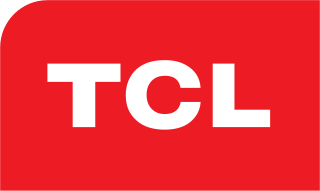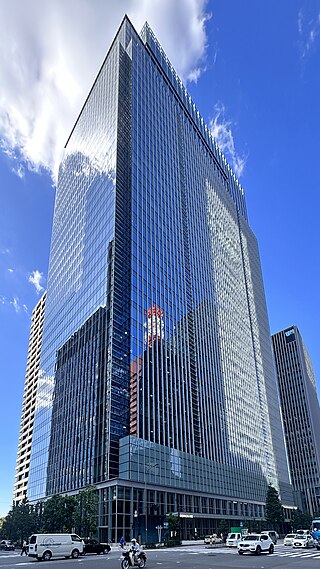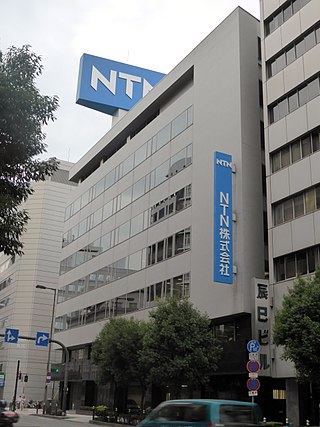
Hitachi, Ltd. is a Japanese multinational conglomerate founded in 1910 and headquartered in Chiyoda, Tokyo. The company specialises in a diverse range of products, including digital systems, power and renewable energy solutions, railway systems, healthcare products, and financial systems.

The organic light-emitting diode (OLED), also known as organic electroluminescentdiode, is a light-emitting diode (LED) in which the emissive electroluminescent layer is a film of organic compound that emits light in response to an electric current. This organic layer is situated between two electrodes; typically, at least one of these electrodes is transparent. OLEDs are used to create digital displays in devices such as television screens, computer monitors, and portable systems such as smartphones and handheld game consoles. A major area of research is the development of white OLED devices for use in solid-state lighting applications.

Mitsuke is a city located in Niigata Prefecture, Japan. As of 31 December 2020, the city had an estimated population of 39,908 in 15,139 households, and a population density of 510 persons per km². The total area of the city is 77.01 square kilometres (29.73 sq mi), making it the smallest city in Niigata Prefecture in terms of area.

NEC Corporation is a Japanese multinational information technology and electronics corporation, headquartered at the NEC Supertower in Minato, Tokyo, Japan. It provides IT and network solutions, including cloud computing, artificial intelligence (AI), Internet of Things (IoT) platform, and telecommunications equipment and software to business enterprises, communications services providers and to government agencies, and has also been the biggest PC vendor in Japan since the 1980s when it launched the PC-8000 series.
Applied Materials, Inc. is an American corporation that supplies equipment, services and software for the manufacture of semiconductor chips for electronics, flat panel displays for computers, smartphones, televisions, and solar products. Integral to the growth of Silicon Valley, the company also supplies equipment to produce coatings for flexible electronics, packaging and other applications. The company is headquartered in Santa Clara, California, and is the largest supplier of semiconductor equipment in the world based on revenue.

Atlas Copco is a Swedish multinational industrial company that was founded in 1873. It manufactures industrial tools and equipment.

A field-emission display (FED) is a flat panel display technology that uses large-area field electron emission sources to provide electrons that strike colored phosphor to produce a color image. In a general sense, an FED consists of a matrix of cathode ray tubes, each tube producing a single sub-pixel, grouped in threes to form red-green-blue (RGB) pixels. FEDs combine the advantages of CRTs, namely their high contrast levels and very fast response times, with the packaging advantages of LCD and other flat-panel technologies. They also offer the possibility of requiring less power, about half that of an LCD system. FEDs can also be made transparent.
Futaba Corporation is a Japanese company founded in 1948, originally to produce vacuum tubes. As time passed, production and elemental techniques of the vacuum tube transformed into the manufacturing of vacuum fluorescent displays (VFDs), tool and die set components, radio control equipment and OLED displays.

TCL Technology is a Chinese partially state-owned electronics company headquartered in Huizhou, Guangdong Province. It designs, develops, manufactures, and sells consumer products including television sets, mobile phones, air conditioners, washing machines, refrigerators, and small electrical appliances. In 2010, it was the world's 25th-largest consumer electronics producer. It became the second-largest television manufacturer by market share by 2019.

FANUC is a Japanese group of companies that provide automation products and services such as robotics and computer numerical control wireless systems. These companies are principally FANUC Corporation of Japan, Fanuc America Corporation of Rochester Hills, Michigan, USA, and FANUC Europe Corporation S.A. of Luxembourg.

A surface-conduction electron-emitter display (SED) was a display technology for flat panel displays developed by a number of companies. SEDs used nanoscopic-scale electron emitters to energize colored phosphors and produce an image. In a general sense, a SED consists of a matrix of tiny cathode-ray tubes, each "tube" forming a single sub-pixel on the screen, grouped in threes to form red-green-blue (RGB) pixels. SEDs combine the advantages of CRTs, namely their high contrast ratios, wide viewing angles, and very fast response times, with the packaging advantages of LCD and other flat panel displays.
Atomic layer deposition (ALD) is a thin-film deposition technique based on the sequential use of a gas-phase chemical process; it is a subclass of chemical vapour deposition. The majority of ALD reactions use two chemicals called precursors. These precursors react with the surface of a material one at a time in a sequential, self-limiting, manner. A thin film is slowly deposited through repeated exposure to separate precursors. ALD is a key process in fabricating semiconductor devices, and part of the set of tools for synthesizing nanomaterials.

The Westinghouse Brake & Signal Company Ltd was a British manufacturer of railroad signs. Founded by George Westinghouse, it was registered as "Westinghouse Brake Company" in 1881. The company reorganised in 1920, associating with Evans O'Donnell, and Saxby and Farmer which merged to form the "Westinghouse Brake & Saxby Signal Company". The 'Saxby' would be dropped from their title in 1935.
Amada Co,. Ltd. is a large Japanese manufacturer of metal processing equipment & machinery based in Kanagawa. The company is headed by Mitsuo Okamoto. The company manufactures metal cutting, forming, shearing, and punching machines. The Company also develops factory automation systems and electronic equipment in addition to machine tools. Amada's products are used in fields such as the auto, computer, camera, and electric appliance industries.

Idemitsu Kosan Co., Ltd. is a Japanese petroleum company. It owns and operates oil platforms, refineries, produces and sells petroleum, oils and petrochemical products, and also operates gas stations under the apollostation brand and until 2023, in its own Idemitsu and Shell brands; the Shell brand being used under the license of Royal Dutch Shell.

Veeco is a global capital equipment supplier, headquartered in the U.S., that designs and builds processing systems used in semiconductor and compound semiconductor manufacturing, data storage and scientific markets for applications such as advanced packaging, photonics, power electronics and display technologies.

NTN Corporation is one of the most prominent manufacturers of bearings in Japan, second domestically only to NSK Ltd. The company is one of the largest exporters worldwide of friction-reducing products such as constant-velocity joints.

Japan Display Inc., commonly called by its abbreviated name, JDI, is the Japanese display technology joint venture formed by the merger of the small and medium-sized liquid crystal display businesses of Sony, Toshiba, and Hitachi.
Global OLED Technology LLC develops and administers intellectual property purchased by Korea's LG Group from the Eastman Kodak Company for US$100 million in December 2009. Comprising some 2,200 patents, its portfolio of technologies arises from Kodak's research into organic light emitting diodes which stretches back to the 1970s or early 1980s.













